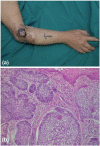Elbow Reconstruction With Compression Plate Arthrodesis and Circumferential Muscle-Sparing Latissimus Dorsi Flap After Tumor Resection: A Case Report
- PMID: 27418897
- PMCID: PMC4920508
- DOI: 10.1177/1558944715614854
Elbow Reconstruction With Compression Plate Arthrodesis and Circumferential Muscle-Sparing Latissimus Dorsi Flap After Tumor Resection: A Case Report
Abstract
Background: The goals of limb-sparing surgery in the setting of extremity malignancies are 2-fold: oncological clearance and the rehabilitation of function and aesthetics. Treatment success should be defined by the extent of restoration of the patient's premorbid function for reintegration into society.
Methods: We would like to report an unusual case of a patient with a chronically ankylosed elbow with joint invasion by basal cell carcinoma which resulted from malignant transformation of an overlying, long-standing wound due to inadequately treated septic arthritis from his childhood years.
Results: Following R0 resection, upper limb shortening and compression plate elbow arthrodesis were performed with the aim of restoring the degree of upper limb function that the patient had been accustomed to preoperatively. The resultant circumferential defect was then closed with a contralateral, free muscle-sparing latissimus dorsi flap.
Conclusions: Functional preservation may therefore be more important than the mere restoration of anatomical defects in these especially challenging situations.
Keywords: arthrodesis; elbow; free flap; limb salvage; upper extremity.
Conflict of interest statement
Figures






Similar articles
-
The pedicled descending branch muscle-sparing latissimus dorsi flap for trunk and upper extremity reconstruction.J Plast Reconstr Aesthet Surg. 2010 Apr;63(4):623-32. doi: 10.1016/j.bjps.2009.01.059. Epub 2009 Mar 20. J Plast Reconstr Aesthet Surg. 2010. PMID: 19303832
-
Functional Latissimus Dorsi Transfer for Upper-Extremity Reconstruction: A Case Report and Review of the Literature.Eplasty. 2017 Feb 17;17:e5. eCollection 2017. Eplasty. 2017. PMID: 28293330 Free PMC article.
-
[Reconstructive surgery in the head-neck area with regional and free tissue transfer].Laryngorhinootologie. 1996 Aug;75(8):476-82. doi: 10.1055/s-2007-997618. Laryngorhinootologie. 1996. PMID: 8962610 German.
-
Elbow flexion reconstruction after arm-sparing excision for high-grade triton sarcoma: a case report.J Med Case Rep. 2020 Jul 4;14(1):103. doi: 10.1186/s13256-020-02384-y. J Med Case Rep. 2020. PMID: 32620140 Free PMC article.
-
Successful Restoration of Elbow Extension Using the Latissimus Dorsi Flap: Case Report.Plast Reconstr Surg Glob Open. 2022 Feb 15;10(2):e4121. doi: 10.1097/GOX.0000000000004121. eCollection 2022 Feb. Plast Reconstr Surg Glob Open. 2022. PMID: 35186647 Free PMC article.
Cited by
-
Soft Tissue Reconstruction of Complete Circumferential Defects of the Upper Extremity.Arch Plast Surg. 2017 Mar;44(2):117-123. doi: 10.5999/aps.2017.44.2.117. Epub 2017 Mar 15. Arch Plast Surg. 2017. PMID: 28352600 Free PMC article.
-
Free Flap Surgery for Elbow Soft Tissue Reconstruction Using the Brachial Artery as Recipient Vessel: Evaluation of MPETS Cases and Comparative Literature Review.Medicina (Kaunas). 2025 Feb 8;61(2):295. doi: 10.3390/medicina61020295. Medicina (Kaunas). 2025. PMID: 40005414 Free PMC article.
-
Acute shortening of upper extremity in orthopaedic patients: a scoping review.Eur J Trauma Emerg Surg. 2025 Jun 11;51(1):225. doi: 10.1007/s00068-025-02904-9. Eur J Trauma Emerg Surg. 2025. PMID: 40498331 Free PMC article.
References
-
- Anwar U, Al Ghazal SK, Ahmad M, Sharpe DT. Horrifying basal cell carcinoma forearm lesion leading to shoulder disarticulation. Plast Reconstr Surg. 2006;117:6e-9e. - PubMed
-
- Bray PW, Bell RS, Bowen CV, Davis A, O’Sullivan B. Limb salvage surgery and adjuvant radiotherapy for soft tissue sarcomas of the forearm and hand. J Hand Surg Am. 1997;22:495-503. - PubMed
-
- Koller H, Kolb K, Assuncao A, Kolb W, Holz U. The fate of elbow arthrodesis: indications, techniques, and outcome in fourteen patients. J Shoulder Elbow Surg. 2008;17:293-306. - PubMed
-
- Kopp J, Polykandriotis E, Loos B, et al. Giant rodent ulcer of the elbow requiring defect coverage by preconditioned latissimus dorsi pedicled myocutaneous flap following excision. J Eur Acad Dermatol Venereol. 2007;21:252-254. - PubMed
LinkOut - more resources
Full Text Sources
Other Literature Sources

